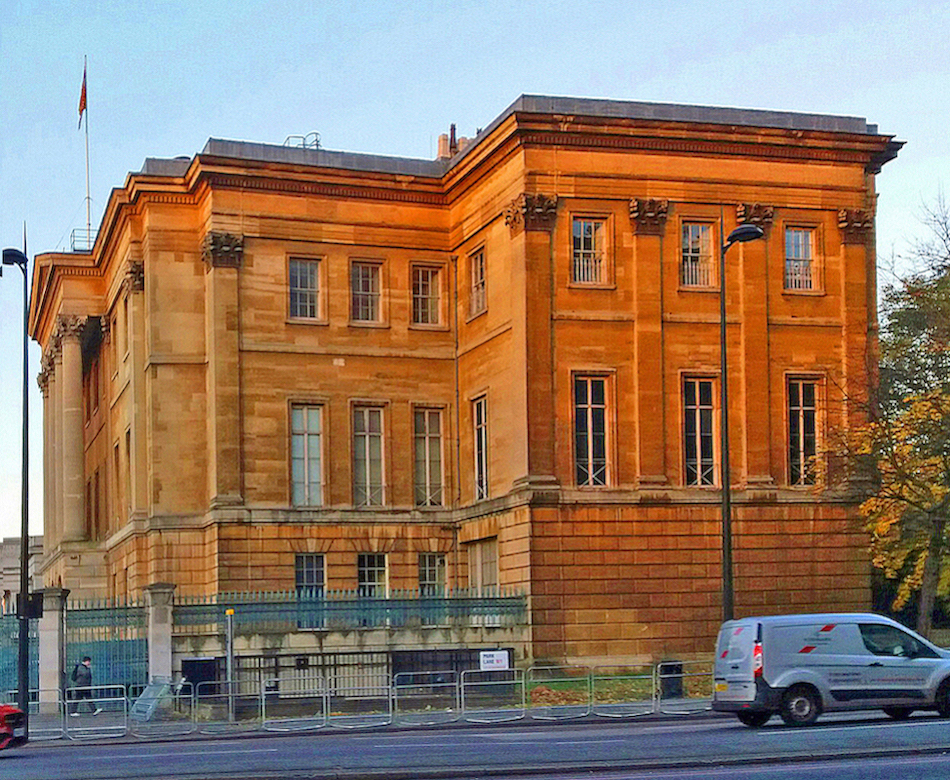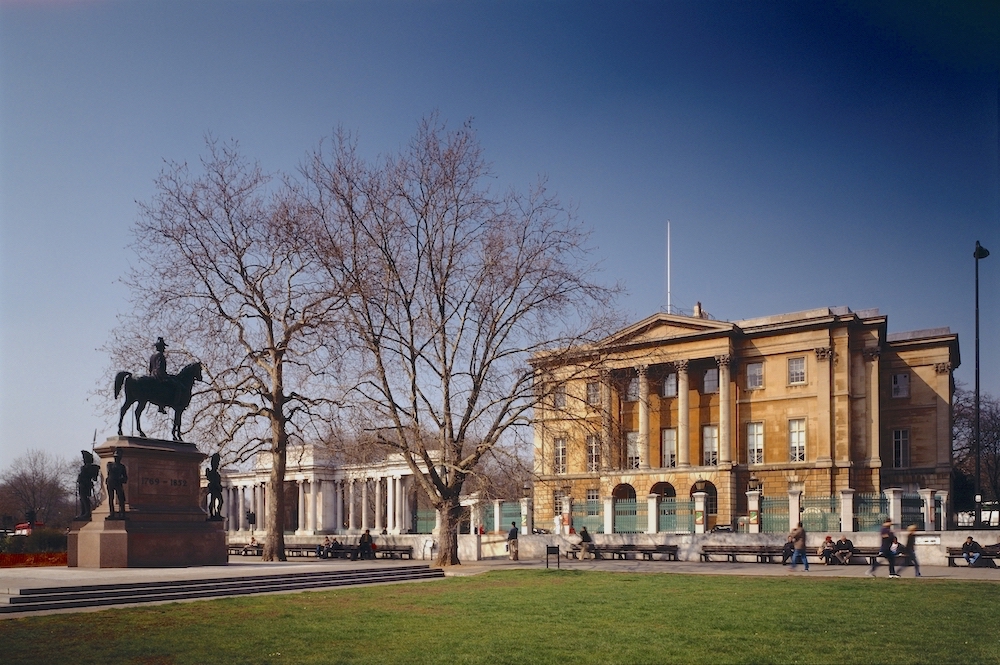Photographs kindly contributed by English Heritage, Apsley House, in connection with the review of their exhibition, "Young Wellington in India," 23 March-3 November 2019. If you wish to reproduce any of the images, you need to contact English Heritage. For opening times and special events at Apsley House, please see (offsite) its own very informative website.

Left: Apsley House from Hyde Park Corner, flying the Duke of Wellington's standard.
Apsley House, the London residence of the present Duke of Wellington, and home also to the Wellington Museum, is a Grade I listed building at Hyde Park Corner. In its original form it was designed and built for the 1st Baron Apsley (1714-1794) by that most fashionable of Regency architects, Robert Adam, in 1771-78. This was the period when Apsley was Lord Chancellor. In 1775 Apsley succeeded his father as the 2nd Earl of Bathurst, but the house retained its name.


Apsley House from Hyde Park. Adjacent to it on the right is Decimus Burton's Hyde Park Screen.
There could not have been a better address. Richard Wellesley, the first Marquess Wellesley, and the eldest brother of Arthur Wellesley, the future Duke of Wellington, acquired the lease of "Number 1, London" in 1807. He then set about leaving his own mark on it, contacting the well-known architect James Wyatt to carry out alterations. Over the next few decades, the square red-brick house would be completely transformed. The extent of James Wyatt's initial work is unclear — in fact, "no details survive of his interventions" (see "Research on Apsley House" ). But it seems that costs were already escalating. To spare his brother the fate of bankruptcy, the Duke of Wellington stepped in, buying him out anonymously in 1817 with a sum awarded by the government after his victory at Waterloo, and earmarked for a new London home. This would be it: in 1830, Welllington negotiated successfully for the freehold of the house (see "History of Apsley House"), and it has been in the family ever since.

The new stairs, with the statue of Napoleon beside them. [Click on this image for a larger one, and for more information about the statue.]
Wellington then took over the remodelling. James Wyatt's son Benjamin Dean Wyatt had served as his secretary in Ireland from 1807, and was a natural choice for the work. According to the listing text, his younger brother Philip (1785-1835) collaborated with him here. In the first stage, which started in 1819, the house was extended to the north-east. The three-story addition gave space for more bedrooms and dressing-rooms, and an impressive State Dining-Room on the first floor. This stage was completed in 1820; the next began in 1828, after the Duke became Prime Minister for the first time. This was when the house was extended to the west, encased in Bath stone, and acquired its entrance portico. Internally, in the older part of the house, a new grand staircase was put in, leading up to the main public rooms on the first floor.
The most impressive of these rooms is the long gallery, a long double-height room along the west front of the house overlooking Hyde Park. This is where many of the masterpieces in the Duke's large collection of paintings are displayed. It is also where the Duke would hold his annual commemorative Waterloo Banquets. These, as can be imagined, were very grand affairs. "At 7, Albert went in uniform, to the Waterloo Dinner, at the Duke of Wellington's," wrote Queen Victoria in her journal on 18 June 1842. Described as "one of the great interiors of Britain," the gallery "was designed in an opulent gilded Louis XIV style, with seven mirrored window shutters inspired by the Galerie des Glaces at the Palace of Versailles" ("Description of Apsley House").


Left: The Waterloo Gallery. Right: The Piccadilly Drawing Room, which has its original Adams ceiling.
Like the State Dining-Room and Yellow and Striped Drawing Rooms, the Waterloo Gallery shows "the Regency taste for decorative effects such as white and gold panelling, scagliola (fake marble) finishes and grand, scrolling ironwork" ("Significance of Apsley House"). Philip Davies has pointed out that it is rare for such interiors to have been preserved, because they are "vulnerable to the whims of their owners and the vicissitudes of fashion" (13). Apsley House has not been immune to change: for instance, according to the listing text, Philip Hardwick carried out further work on the house in 1853. However, that so much has been preserved here is a matter for rejoicing.

The Striped Drawing Room. The large painting on the right is The Battle of Waterloo by Sir William Allan, painted in 1843.
Apsley House continues to be the London residence of the current Duke of Wellington, but the public rooms are open to visitors under the auspices of English Heritage. As well as the ground floor museum room and the other rooms mentioned here, there are two further drawing rooms and a great number of artworks to enjoy, including several by Velásquez, and many items in different media — sculptured busts, Dresden and other fine china dinner services, metalwork in silver, gilt silver, and bronze, and so on. It is worth noting too that joint entry tickets entitle visitors to go inside the nearby Wellington Arch — and up to the exhibition spaces and viewing platforms, affording panoramic views over London. An important portion of British history comes alive here in the most tangible and memorable way.

View of Apsley House in the evening, showing both the Wellinton Arch and Sir Edgar Boehm's statue of the Duke on his favourite horse, Copenhagen, facing it.
By way of conclusion: the triumphal arch in front of Apsley House was not the only tribute paid to Wellington in its immediate vicinity. In 1822, during his early years in the house, Sir Richard Westmacott's statue representing him as the Greek hero Achilles was unveiled behind it. Later on, in 1888, Sir Edgar Boehm's commemorative statue of the Duke on his horse Copenhagen, was installed in front it. Both inside and out, in his own lifetime and beyond it, Apsley House was indeed "a fitting setting for a national hero" (Thompson 83).
Related Material
- [Review of] "Young Wellington in India" (exhibition at Apsley House, 2019)
- Westmacott's Achilles, Hyde Park
- The Wellington (or Constitution) Arch by Decimus Burton
- Boehm's Wellington monument, Hyde Park Corner
- Hyde Park and Kensington Gardens, London
Sources
Apsley House, 149, Piccadilly,City of Westminster (listing text). Historic England. Web. 10 June 2019.
Davies, Philip. London Hidden Interiors. Croxley Green, Herts.: Atlantic Publishing, 2012. (Note: like other houses which are regularly open to the public, Apsley House itself is not featured here).
"Description of Apsley House." English Heritage. Web. 10 June 2019.
"History of Apsley House." English Heritage. Web. 10 June 2019.
Queen Victoria's Journals. Online ed. Vol. 13, p.326
"Research on Apsley House." English Heritage. Web. 10 June 2019.
"Significance of Aspley House." English Heritage. Web. 10 June 2019.
Thompson, Neville. Wellington after Waterloo. Routledge Revivals. London: Routledge, 2016.
Last modified 31 October 2023